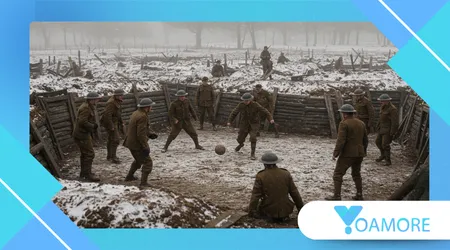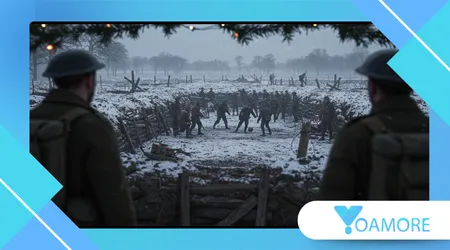The Christmas Truce of WWI: When Soldiers Played Soccer in No Man’s Land

Few events in military history capture such a striking contradiction as The Christmas Truce of WWI.
Anúncios
On a battlefield where death and destruction had become daily realities, soldiers unexpectedly found themselves setting aside weapons, shaking hands, and even playing soccer.
In the frozen expanse of No Man’s Land, men who only hours before were sworn enemies briefly transformed the frontlines into a space of humanity.
More than a romanticized anecdote, the truce reveals the power of shared traditions and the fragile nature of war itself.
This article unfolds the historical context, the spontaneous events of the truce, and its enduring legacy, while reflecting on what lessons it continues to hold for the present. Here’s what you will discover:
Anúncios
- How the brutality of trench warfare set the stage for unexpected gestures of goodwill.
- Why Christmas carols and small acts of kindness sparked an informal ceasefire.
- How soccer became the universal symbol of connection during the truce.
- What numbers reveal about its reach and significance.
- The reactions from commanders and the contrast between frontline and political perspectives.
- Why this story still resonates today, offering parallels to modern conflicts.
Context: The Great War Before the Truce
By December 1914, the Western Front had settled into a stalemate. Soldiers endured weeks of mud, lice, and bitter cold, facing artillery barrages that reduced landscapes to wastelands.
Fear was constant, yet so was boredom. The monotony of trench life, broken only by sudden bursts of violence, created conditions where soldiers yearned for normalcy.
Against this backdrop, the approach of Christmas triggered thoughts of home, family, and traditions left behind.
In letters sent back to Britain and Germany, troops described how the familiar sounds of carols drifted across the barbed wire.
Silent Night, sung in German as “Stille Nacht,” was answered by British soldiers with their own hymns.
The shared melodies softened the hostility of the trenches, replacing for a brief moment the roar of artillery with music.
What made the truce remarkable is that it was not ordered, negotiated, or sanctioned. It emerged from men who, despite the horror around them, instinctively sought a human connection.
In a war shaped by technology and strategy, the truce was a reminder that individual soldiers carried their own sense of dignity and compassion.
+ Why “Cringe” Is a Cultural Term and Not Just a Feeling
When Soldiers Stepped into No Man’s Land

On Christmas Eve, lights began appearing along the German trenches—candles placed on makeshift trees. British soldiers, curious and cautious, observed from their own lines.
By dawn on Christmas Day, gestures became bolder. A handful of men, unarmed, ventured into the contested ground that separated the two sides.
What followed was astonishing. Men who hours earlier had exchanged gunfire now extended their hands. Cigarettes, tins of food, and buttons were swapped as tokens of goodwill.
In some accounts, soldiers even helped bury fallen comrades lying in No Man’s Land, a silent acknowledgment of shared suffering.
Private Frederick Heath later wrote, “We shook hands, wished each other a Merry Christmas, and exchanged souvenirs.”
Such testimonies highlight that this was not a rehearsed display but a spontaneous release of humanity.
The ground between the trenches transformed from a symbol of division into one of fellowship.
The image of soccer soon entered the story. In certain sectors, soldiers produced balls or improvised with stuffed sacks, kicking them across the mud.
Though the matches were far from organized competitions, they embodied the essence of camaraderie.
The act of play, stripped of strategy or politics, demonstrated that the men had far more in common than the uniforms suggested.
+ The Great Hurricane of 1780: The Deadliest Tropical Cyclone in the Western Hemisphere
Soccer: More Than Just a Game
Why did soccer resonate so strongly during The Christmas Truce of WWI? The answer lies in its accessibility.
By 1914, football had spread widely across Europe, with many soldiers already familiar with the sport.
Unlike card games or songs, soccer required movement and teamwork, forcing participants to cooperate rather than compete in hostility.
For soldiers from villages, towns, and cities where local clubs played weekly matches, soccer was second nature. It allowed them to reconnect with the rhythm of ordinary life.
A kick, a laugh, a cheer—these were fragments of home carried into the trenches. Soccer became a bridge, a way to communicate without words.
Imagine two rivers that had been forced apart suddenly converging into one. For those brief hours, the current flowed in unity.
The ball replaced bullets; cheers replaced cries of pain. The simplicity of the game illuminated the absurdity of conflict, showing how easily the same men could have been teammates rather than enemies.
This symbolism has endured. Soccer during the truce stands as more than a pastime; it represents the human instinct to replace violence with play and to find connection in shared joys.
+ The Battle of Schrute Farms: A Forgotten Civil War Skirmish
The Numbers Behind the Story
Although not universal, historians estimate that nearly 100,000 soldiers took part in some form of ceasefire along the Western Front (source: Imperial War Museums).
The scope was broad enough to cover nearly two-thirds of certain frontline sectors, though its intensity varied from place to place.
| Estimated Participation in the Christmas Truce (1914) |
|---|
| Soldiers involved (approx.) – 100,000 |
| Length of frontlines affected – 2/3 of certain areas |
| Typical duration – 24 to 48 hours |
Numbers alone cannot convey the emotional resonance of the truce. For men accustomed to relentless shelling, even a single day without fear was invaluable.
Letters home reflected astonishment: families read about fraternization with disbelief, realizing their sons had seen more humanity in their enemies than their leaders admitted.
Statistically, the truce was a small pause in a war that eventually claimed over 16 million lives.
Yet in symbolic terms, it has far outweighed its scale, reminding us that even in vast conflicts, individual choices can rewrite the narrative.
How Commanders and Governments Reacted
Military leaders did not share the enthusiasm of their men. High command on both sides worried that fraternization would weaken discipline.
Orders were quickly circulated forbidding further truces, and by Christmas 1915, the war’s brutality had escalated to the point where similar gestures were nearly impossible.
Newspapers were divided in their coverage. Some described touching stories of handshakes and songs, while others minimized or ignored the truce, framing it as a dangerous distraction.
The gap between those who fought and those who commanded became clearer than ever.
For many soldiers, however, the memory lingered. In diaries and recollections, they described the truce not as weakness but as sanity breaking through madness.
As historian Malcolm Brown noted, the truce revealed “a protest against the mechanical destruction of war.”
Memory and Meaning Across a Century
The story of The Christmas Truce of WWI has grown in cultural significance. It has been reimagined in novels, films, and even global advertising campaigns.
In 2014, during the centenary, UEFA and the English FA organized memorial matches, underscoring soccer’s symbolic role in the event.
Schools across Europe marked the occasion with lessons on peace and solidarity.
Commemorations often emphasize the paradox: how could such humanity emerge in the middle of industrialized killing?
The truce serves as a reminder that conflict is not inevitable, and that even ordinary soldiers can resist systems of destruction through simple acts of kindness.
It also reveals the contrast between lived experience and official narratives. While governments sought to erase or minimize the truce, its memory has endured because it resonated with ordinary people.
In collective memory, it represents the moment when war’s logic was briefly suspended.
Why the Truce Still Resonates Today
The enduring relevance of the truce lies in its simplicity. It was not planned, politically negotiated, or even strategically significant.
Yet it has outlasted military victories in cultural memory because it appeals to a universal longing: the desire for peace.
In today’s fractured world, divided by political polarization and global crises, the truce poses a question that remains urgent: if exhausted soldiers could lay down their weapons in the mud of Flanders, what prevents societies from finding common ground today?
This reflection makes the truce not just a historical curiosity but a moral touchstone. It is a story we revisit because it challenges cynicism.
If peace could exist for a day in 1914, then it can exist again, not as an anomaly but as a choice.
Two Lessons from the Truce
- Shared experiences create bonds. Just as soccer united soldiers across languages and allegiances, modern societies can rely on culture, sports, and art as bridges over division. A stadium, a concert, or even a shared digital space can provide common ground.
- Peace often rises from the bottom. The truce was not designed by generals but initiated by ordinary men. This shows how grassroots actions can inspire change, whether through local activism or global movements.
Think of the truce as a candle in a vast cavern of darkness. Alone, it could not stop the shadows.
Yet it illuminated enough to remind those present that light still existed. That fragile illumination continues to glow through history.
Frequently Asked Questions
Did the Christmas Truce happen everywhere?
No. It was most widespread in Flanders, but some areas continued fighting throughout Christmas. The truce was localized and varied in intensity.
Were soccer matches formally organized?
Not at all. They were informal kickabouts, often with improvised balls and goals. Their symbolic resonance, however, has overshadowed their informality.
Why did it only occur in 1914?
By 1915, the war had escalated significantly. Chemical weapons were introduced, casualties multiplied, and military authorities imposed stricter controls. The spirit of the truce could not survive those conditions.
What is its cultural impact today?
The truce is remembered as a symbol of peace and human resilience. It continues to inspire art, education, and sports. You can read further at History.com.
Conclusion: Humanity Amid War
The Christmas Truce of WWI remains one of the most extraordinary episodes of the 20th century.
It neither altered the war’s trajectory nor resulted in peace treaties, yet its moral weight continues to outshine its military insignificance.
For one day, soldiers reclaimed their humanity. They sang, laughed, exchanged gifts, and played soccer where death usually reigned.
They revealed that war, for all its machinery, cannot entirely suppress the human impulse for empathy.
The truce challenges us still. If enemies entrenched in mud could pause to treat each other as equals, what excuses do we have in a world with far greater means of connection?
Its lesson is not only historical but timeless: peace is fragile, but always possible.
